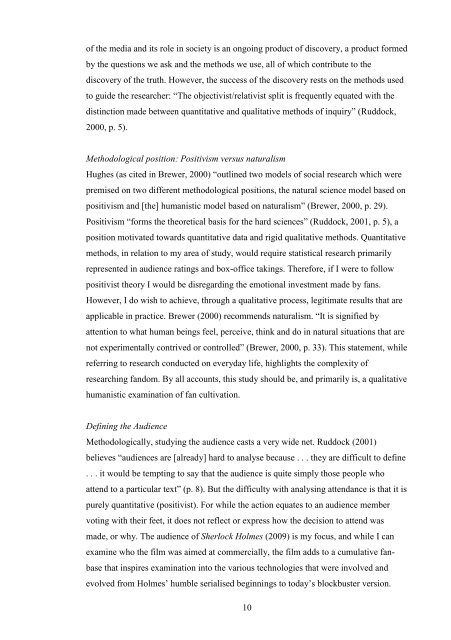The Case Study of Sherlock Holmes (2009) - Scholarly Commons ...
The Case Study of Sherlock Holmes (2009) - Scholarly Commons ...
The Case Study of Sherlock Holmes (2009) - Scholarly Commons ...
You also want an ePaper? Increase the reach of your titles
YUMPU automatically turns print PDFs into web optimized ePapers that Google loves.
<strong>of</strong> the media and its role in society is an ongoing product <strong>of</strong> discovery, a product formed<br />
by the questions we ask and the methods we use, all <strong>of</strong> which contribute to the<br />
discovery <strong>of</strong> the truth. However, the success <strong>of</strong> the discovery rests on the methods used<br />
to guide the researcher: “<strong>The</strong> objectivist/relativist split is frequently equated with the<br />
distinction made between quantitative and qualitative methods <strong>of</strong> inquiry” (Ruddock,<br />
2000, p. 5).<br />
Methodological position: Positivism versus naturalism<br />
Hughes (as cited in Brewer, 2000) “outlined two models <strong>of</strong> social research which were<br />
premised on two different methodological positions, the natural science model based on<br />
positivism and [the] humanistic model based on naturalism” (Brewer, 2000, p. 29).<br />
Positivism “forms the theoretical basis for the hard sciences” (Ruddock, 2001, p. 5), a<br />
position motivated towards quantitative data and rigid qualitative methods. Quantitative<br />
methods, in relation to my area <strong>of</strong> study, would require statistical research primarily<br />
represented in audience ratings and box-<strong>of</strong>fice takings. <strong>The</strong>refore, if I were to follow<br />
positivist theory I would be disregarding the emotional investment made by fans.<br />
However, I do wish to achieve, through a qualitative process, legitimate results that are<br />
applicable in practice. Brewer (2000) recommends naturalism. “It is signified by<br />
attention to what human beings feel, perceive, think and do in natural situations that are<br />
not experimentally contrived or controlled” (Brewer, 2000, p. 33). This statement, while<br />
referring to research conducted on everyday life, highlights the complexity <strong>of</strong><br />
researching fandom. By all accounts, this study should be, and primarily is, a qualitative<br />
humanistic examination <strong>of</strong> fan cultivation.<br />
Defining the Audience<br />
Methodologically, studying the audience casts a very wide net. Ruddock (2001)<br />
believes “audiences are [already] hard to analyse because . . . they are difficult to define<br />
. . . it would be tempting to say that the audience is quite simply those people who<br />
attend to a particular text” (p. 8). But the difficulty with analysing attendance is that it is<br />
purely quantitative (positivist). For while the action equates to an audience member<br />
voting with their feet, it does not reflect or express how the decision to attend was<br />
made, or why. <strong>The</strong> audience <strong>of</strong> <strong>Sherlock</strong> <strong>Holmes</strong> (<strong>2009</strong>) is my focus, and while I can<br />
examine who the film was aimed at commercially, the film adds to a cumulative fan-<br />
base that inspires examination into the various technologies that were involved and<br />
evolved from <strong>Holmes</strong>‟ humble serialised beginnings to today‟s blockbuster version.<br />
10

















